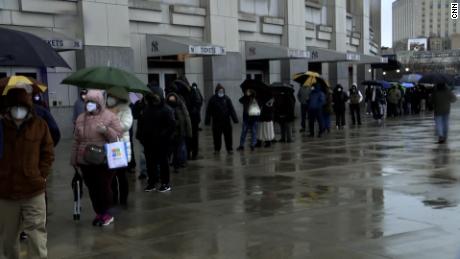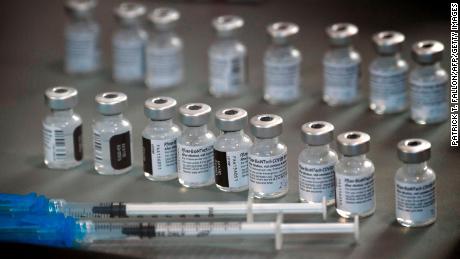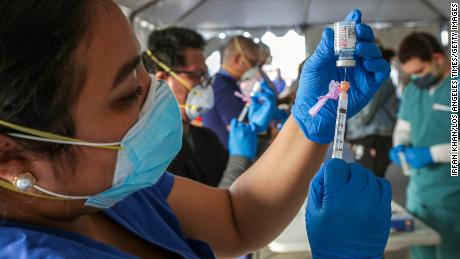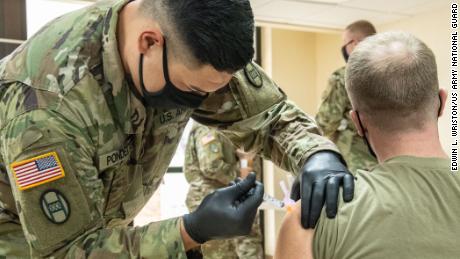US is making vaccine progress, and experts are encouraged
“Overall, things are definitely getting better,” Dr. Paul Offit, director of the vaccine education center at the Children’s Hospital of Philadelphia, told CNN Friday.
An FDA advisory committee will meet about the request February 26. The panel will make a recommendation that the FDA will consider when it makes a decision about whether to authorize.
And experts have pointed to potential advantages: Unlike the Pfizer and Moderna vaccines, Johnson & Johnson’s would take only one shot; it does not have to be stored in freezers; and it can be stored for three months at refrigerator temperatures.
The addition of a new vaccine will boost supply and allow more people to be inoculated faster, Offit and other experts have said.
And “the weather is going to get warmer, and when that happens, it makes it less easy for this virus to be transmitted,” Offit said.
“I really do think that we will get on top of this by summer or late summer, because I think everything now is moving in the right direction,” Offit said.
Dr. Ashish Jha, dean of Brown University’s school of public health, also said Friday the vaccination situation in the US “is getting better.”
New York to offer vaccines to people with underlying conditions
New York may be the first state to offer vaccine access to people with comorbidity, or the simultaneous presence of two or more medical conditions, no matter their age.
The governor’s office listed cancer, chronic kidney disease, pulmonary disease and heart conditions as some of the comorbidities and underlying conditions that the state will use to determine eligibility for the Covid-19 vaccine.
Starting February 15, doses reserved for hospital workers will be reallocated to those with comorbidities if hospital workers haven’t used them, Cuomo said Friday.
About 75% of hospital workers have been vaccinated, and those who haven’t will have until then to get their shots before access is opened to others.
Health departments will work with the state and the CDC to further determine which medical conditions qualify.
Model predicts steadily dropping death rate — unless variants intervene
How quickly the variants spread versus the speed of vaccinations will be a key factor in the number of coronavirus deaths over the coming months, according to a forecast from the Institute for Health Metrics and Evaluation at the University of Washington.
Currently, IHME projects the country’s number of Covid-19 deaths per day will drop steadily through June 1, in part because of vaccine rollouts and polls showing increasing percentages of Americans saying they’re willing to get vaccines.
The US has averaged more than 3,230 Covid-19 deaths a day over the past week, not far from the record average of 3,357 set on January 13, according to Johns Hopkins University.
But in a worst-case scenario, including rampant variant spread, daily death rates could rise again by March — and even exceed 2,600 a day by mid-April before dipping, the IHME says.
“If the variants are more widespread and people go back to their previous life faster” after being vaccinated, “then you get closer to our worst scenario that we put out,” IHME Director Dr. Chris Murray told CNN’s Anderson Cooper Friday night.
Genetic tests showed that the patient, who had an underlying condition that weakened his immunity, had been infected with the same virus all along but that it had been evolving as it replicated.
“It was incredible,” said Dr. Jonathan Li, who leads a lab at Brigham and Women’s Hospital in Boston studying viruses and their mutations and had been called in to help study the patient’s case.
For now, Covid-19 cases and hospitalizations in the US have been dipping after a holiday-era surge.
The country has averaged about 130,402 new Covid-19 cases a day over the last week — down more than 47% since a peak average of more than 249,000 a day on January 8, according to Johns Hopkins data.
The number of people in US hospitals Thursday was 88,688 — the lowest since November 24.
CDC director: Guidance on reopening schools to be released in the coming week
“Our goal is to get children back to school,” Walensky said Friday. “Schools should be the last places closed and the first places open. Our goal is to make sure in getting children back to school that we do so both with the safety of the children and the safety of the teachers” in place.
“Among the things that we need to do to make sure that schools are safe is to make sure that the community spread of the disease is down,” Walensky said. “We are actively working on the guidance, the official guidance, which will be released in the week ahead.”
So far, 24 states and Washington, DC, are explicitly allowing some teachers or school staff to receive the vaccine.
Biden administration plans to make 60 million at-home tests available this summer
The Biden administration announced on Friday that under the Defense Production Act, about 60 million at-home Covid-19 tests will be made available for the public by the end of this summer.
Those tests will be in addition to the at-home tests from the company Ellume that the administration previously announced, Tim Manning, Covid-19 supply coordinator, said during a White House news briefing.
“The country’s well behind where we need to be in testing,” Manning said.
“Over the coming weeks, the US government has plans to invest in another six suppliers to rapidly surge testing capability,” Manning said.
On Monday, Andy Slavitt, the senior Biden White House adviser for Covid response, said during a White House briefing that the US Department of Defense and US Department of Health and Human Services are working with Australian company Ellume to provide more of its fully at-home Covid-19 tests to the United States and ship 100,000 test kits per month to the United States from February through July.
Now, “having 60 million more at-home tests available over the course of the summer is exactly what the country needs,” Slavitt said during Friday’s briefing.
CNN’s Michael Nedelman, Maggie Fox, Andrea Diaz, Jacqueline Howard, Sara Murray, Naomi Thomas, Kristina Sgueglia and Theresa Waldrop contributed to this report.
![]()












